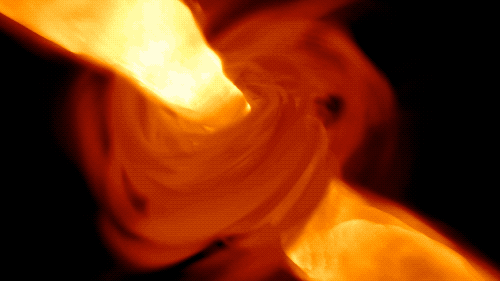A Sense of Doubt blog post #1524 - The Picture of the Black Hole and the Misognyny that followed
So, I am behind again. I have to figure out how to make my week work, so that I am not posting four or five entries on Saturday and Sunday because that's not so daily, innit?
Anywho, I had this one set up to go because it's cool. At first, I had linked an initial story of the first picture of a black hole from WIRED, and then I added an article Kurzweil posted claiming that black holes could be a mathematical impossibility. This claim will make some wonder how then we have a picture of a black hole. Indeed.
Before I add that answer, allow me to share the nature of other content. In between these two articles is some content from Facebook about some serious misogyny directed at Dr. Katie Bouman, the principle scientist responsible for the work. I added some Twitter messages as well that tell the tale.
If you read on, you will come across the "information loss paradox" of how black holes exist and yet what they do (remove anything from our universe) cannot exist. Neither idea negates the picture of the black hole, which was constructued via algorithm from data gathered over a five day period; thus, it is not a "snapshot," an instant in time as most people think of photographs.
For some reason, and interestingly given what follows, the WIRED article does not mention Dr. Bouman.
Read on. Insecure male scientists (and non-scientists) are very threatened by women who accomplish things in science and want to take the credit away from them.
We live in a time in which not only are FACTS UNDER FIRE and a sector of the government that would turn our country into something far worse than the HANDMAID'S TALE.
In little ways, by denying the work of women scientists, we're already there.
 |
The Event Horizon Telescope has captured a photo of a supermassive black hole at the center of M87, a galaxy 54 million light years away.
EVENT HORIZON TELESCOPE COLLABORATION ET AL.
|
SCIENTISTS REVEAL THE FIRST PICTURE OF A BLACK HOLE
IN THE CENTURY since Einstein predicted the existence of black holes in his theory of gravity, astrophysicists have turned up overwhelming evidence for the things. They’ve observed the push and pull of black holes on the orbits of nearby stars and planets. They’ve heard the vibrations, or gravitational waves, resonating from black holes colliding. But they’d never glimpsed a black hole face to face—until now. On Wednesday, astrophysicists announced they had captured the first-ever image of a black hole.
The picture, taken over five days of observations in April 2017 using eight telescopes around the world by a collaboration known as the Event Horizon Telescope, depicts luminous gas swirling around a supermassive black hole at the center of M87, a galaxy 54 million light-years away. Past the bright lights, though, is the black hole’s telltale feature: its event horizon. The event horizon is the edge of the spacetime abyss, where gravity is so strong that no light can escape from it. “It’s the point of no return,” says Feryal Özel of the University of Arizona, who is a member of the EHT collaboration. In the image, it manifests itself as the “sudden absence of light,” she says.
Previously, researchers had captured a blobby jet of light emerging from where the M87 black hole was predicted to be—but they couldn’t definitively see the black hole because their instruments were nowhere near as sharp as EHT’s. “It’s like going from a cheap smartphone camera to a high definition IMAX cinema,” says astrophysicist Andrew Strominger of Harvard University, who was not involved in the work.
 |
The South Pole Telescope, one of eight telescopes used to capture the first black hole image.
|
This black hole is about 6.5 billion times the mass of the sun. Still, it’s tiny from a vantage point on Earth, less than 50 microarcseconds wide in the sky, which makes it about as hard to see as a donut placed on the moon. It took eight different telescopes to image it. The telescopes collected observational data that was synced with the precision of a billionth of a second.
To see the black hole’s boundary between light and dark, the astrophysicists captured radio waves—light 1.3 millimeters in wavelength, invisible to the human eye—emitted by the gas swirling around the black hole. The gas emits light of all different wavelengths, including visible light, but the researchers chose this particular wavelength because it can sail through entire galaxies and even Earth’s own atmosphere without being absorbed. But they still needed good weather at all eight of their telescope sites to see the black hole. Before switching on their telescopes, they had to monitor the moisture in the air, says Özel—too much humidity would ruin their images. To minimize the chance of rain, they built the telescopes in dry regions, including the South Pole and the Atacama Desert in Chile.
M87's black hole is relatively close to Earth, as the light coming from it was only emitted 54 million years ago—so we’re seeing it at a more mature moment in its existence. “At this point in the age of the universe, black holes have calmed down,” says Özel. “They’re basically eating gas trickling in from nearby stars.” M87’s black hole does emit bright jets of gas, but it’s still pretty dim compared to younger black holes that are further away. These younger black holes accumulate larger amounts of matter, so their swirls of luminous gas shine brighter.

To capture and interpret the first black hole image, scientists first created millions of simulations like this one.
CHI-KWAN CHAN/UNIVERSITY OF ARIZONA
It took two decades of work to capture the image. Part of that effort was designing, building, and hauling the hardware to various telescope sites. But they also had to anticipate what they might see by nailing down the physics of black holes as accurately as possible. Özel, who has been working on photographing a black hole since her graduate student days in 2000, says that they’ve created millions of simulations of black holes, each with different mass, spin speed, or orientation, among other things. These simulations helped inform how they designed their telescopes and where they pointed them.
But they weren’t just after a pretty picture. In the zoo of astronomical objects, black holes are among the most extreme entities to exist. A black hole, as currently understood, packs an enormous amount of mass into a single point, making it—literally—an infinitely dense object. This density creates a huge gravitational pull into its center, which no one can peer inside. “They are the only objects in the universe that create a region of spacetime inaccessible to the rest of the universe,” says Özel. Because black holes are so extreme, researchers want to study their features to see if they are consistent with the rest of general relativity. “We all feel we have an intuitive sense of what space and time are. But Einstein told us that’s true only in situations like the ones we’re used to, where the gravitational field is very weak,” says Strominger. “When the gravitational field gets strong, there are all sorts of crazy things that happen.”
Everything they’ve observed so far about M87—its mass and the size of its event horizon—is consistent with Einstein's theory. But future, more detailed observations could reveal unexpected features. Strominger wants to see more detailed images of a fast-spinning black hole like M87. According to theoretical calculations, if black holes spin fast enough, they form a wormhole in spacetime. Future black hole images could help confirm or refute these hypotheses. Strominger is anticipating the day when images are good enough to see a black hole with its associated wormhole. “This is really, really weird science fiction stuff, and we’re going to be seeing it,” he says.
This image is just the beginning, says Özel. They want to pivot their telescopes toward other black holes, to amass a whole scrapbook of black hole images. They also plan to take more, better-quality pictures of this black hole to understand it in more detail. Now that they’ve finally stared into the eyes of the beast, it’s time to watch how it behaves.
Watch Dr. Katie Bouman discuss the work behind imaging a black hole @MIT Monday at 11am! https://t.co/NWYa5xUI21 #EventHorizonTelescope #mit #blackhole #EHTblackhole pic.twitter.com/aNetqP3mMZ— MIT CSAIL (@MIT_CSAIL) April 19, 2019
"Just as Bouman’s success was an inspiration to young women and girls in the sciences, the very public attacks on her work as a corollary warning."— Dr. Ann Olivarius (@AnnOlivarius) April 18, 2019
And what they tell ALL women is:
"STAY IN LINE. Just look what happens if you don't". https://t.co/2obeNtAqGu#DownGirl
Dr. Katie Bouman earned her BSE in Electrical Engineering from @umich in 2011, before developing a crucial algorithm that helped devise the imaging method responsible for the first ever photo of a #BlackHole. https://t.co/MyuDjBp2hl pic.twitter.com/hO89oT3xt8— Michigan Engineering (@UMengineering) April 18, 2019
http://www.kurzweilai.net/report-up-for-debate-physicist-says-black-holes-are-a-math-impossibility
report | Up for Debate: physicist says black holes are a math impossibility
Researcher says they might not be exactly what they seem.
April 10, 2019
— the interview —
group: Univ. of North Carolina
story title: Univ. of North Carolina’s Laura Mersini-Houghton PhD shows that black holes do not exist
date: September 2014
story title: Univ. of North Carolina’s Laura Mersini-Houghton PhD shows that black holes do not exist
date: September 2014
read | full story
— the story —
A quandary: black holes don’t exist — according to math calculations by physicist Laura Mersini-Houghton PhD — at the University of North Carolina.
Because black holes are traditionally considered one of the biggest cosmic mysteries — Mersini-Houghton’s statement that they don’t exist has caused controversy. But the science behind the scientific theory of black holes is more complex from a math and physics point of view.
Most of us think of black holes as stars that collapse in massive explosions, causing them to become smaller + denser. Mersini-Houghton isn’t questioning the existence of that. But she is questioning what properties black holes have — such as a singularity within a star’s explosion that creates the event horizon. An event horizon is a point so strong that nothing can escape the pull of the black hole: once something goes into a black hole, it disappears.
The 2 leading theories about our universe contradict this, however. Historic physicist Albert Einstein PhD’s theory of gravity predicts that black holes can form, but his law of quantum theory says that nothing from the universe can ever disappear. Combine the 2 theories creates mathematical nonsense — and is called “the information loss paradox.”
So how can both theories be correct? The only way to combine the 2 concepts is by stating that some properties we associate with black holes don’t exist. That means black holes — as scientists know them, are impossible. Her calculations require scientists to re-imagine the fabric of space, and re-think the origins of our universe.
For many decades, scientists believed that black holes form when a massive star collapses to a single point in space. Imagine planet Earth being squished into a ball the size of a peanut — called a singularity. The event horizon the point where a black hole’s gravitational pull is so strong that nothing can escape it. Crossing this horizon means that you could never cross back.
Experimental evidence may one day show physical proof if black holes exist in the universe or not — and in what form. But for now, Mersini-Houghton says the mathematics are conclusive.
Laura Mersini-Houghton PhD said: “I’m still not over the shock. We’ve been studying this problem for a more than 50 years — and this math solution gives us a lot to think about.”
— the report —
report title: The back-reaction of Hawking radiation on a gravitationally collapsing star — black holes
year: September 2014
author: by Laura Mersini-Houghton PhD
year: September 2014
author: by Laura Mersini-Houghton PhD
— summary —
In her paper Laura Mersini-Houghton PhD uses 2 seemingly conflicting theories to mathematically prove that black holes don’t exist — because they can’t possibly come into existence in the first place. She also references physicist Stephen Hawking PhD.

on the web | reading
Midnight in the Desert | Professor says black holes are mathematically impossible
Tech Times | Physics professor says black holes mathematically impossible
Tech Times | Physics professor says black holes mathematically impossible
on the web | pages
Stephen Hawking PhD | home
[ story file ]
story title: report | Up for Debate: physicist says black holes are math impossibility
deck: Researcher says they might not be exactly what they seem.
year: 2019
section: digest
deck: Researcher says they might not be exactly what they seem.
year: 2019
section: digest
[ end of file ]
+++++++++++++++++++++++++++++++++++++++++++++++++++++++++++++++++++++++
+++++++++++++++++++++++++++++++++++++++++++++++++++++++++++++++++++++++
+++++++++++++++++++++++++++++++++++++++++++++++++++++++++++++++++++++++
- Bloggery committed by chris tower - 1504.23 - 10:10
- Days ago = 1389 days ago
- New note - On 1807.06, I ceased daily transmission of my Hey Mom feature after three years of daily conversations. I plan to continue Hey Mom posts at least twice per week but will continue to post the days since ("Days Ago") count on my blog each day. The blog entry numbering in the title has changed to reflect total Sense of Doubt posts since I began the blog on 0705.04, which include Hey Mom posts, Daily Bowie posts, and Sense of Doubt posts. Hey Mom posts will still be numbered sequentially. New Hey Mom posts will use the same format as all the other Hey Mom posts; all other posts will feature this format seen here.





No comments:
Post a Comment